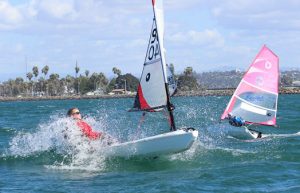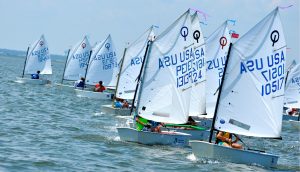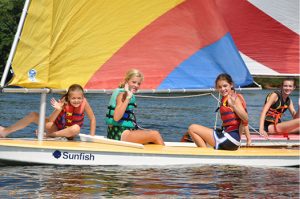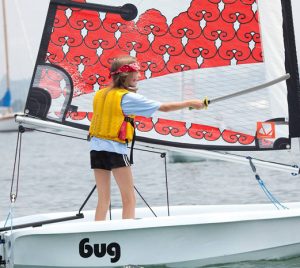By Ben Cesare
In our September issue, my Publisher’s Log made a case against the Optimist as a training boat. In October, we published some letters that agreed with the premise. This month there are some letters in defense. Beyond those, we have gathered many points of view…frankly it’s been exhausting as the topic generates a huge number of stories and opinions. Following is an effort to synthesize and provide a prescription. Luckily for me, I have a dog in this hunt. But then again, ultimately, we all do.
Before we dive in, let’s be clear about what we are after. The discussion is around how many kids are we losing from sailing (any kind of sailing) before the age of 12 and what can we do about it. To justify focusing on the 10 to 12 age group (beyond my own child), I reached out to John Pearce, Youth Director at US Sailing. John is working on a concept he has called Squaring the Pyramid which refers to the concepts we are discussing; essentially, keeping more kids involved in our very broad sport. He is also gathering research from various successful “mainstream” sports around how to use fun as a tool for better teaching sports skills. John referred me to The Aspen Institute, whose Project Play initiative is trying to gather data around American youth sports. One of the most stark pieces of data they have compiled is that kids start specializing in sports between the ages of 10 and 12, depending on the sport. The Aspen Institute provides all kinds of tools to help parents evaluate which sports their kids should play and what other ones are complementary to avoid potentially damaging specialization resulting in burn out or injury. It’s a great resource.

The 9-foot O’Pen BIC delivers mini-skiff performance in a durable thermoformed polyethylene package, and young sailors love the “Un-Regatta” event format. © Aine McLean Fretwell
OK, the competition for our kids’ attentions is fierce…we already knew that. One truth we should acknowledge is that we really don’t teach “sailing”. The vast majority of junior sailing programs teach sailboat racing. Racing competence and ultimately success is the goal, and race and regatta results are the measurements by which we are judging success. Towards that end, the Optimist has performed admirably.
‘An old friend of mine, Peter Cusick, whose son Jack was a key player on the College of Charleston’s National Champion Team in 2017, commented, “Across two junior sailors I never had issue with the Optimist. I honestly think it’s a great class. What is great about the Opti is its rudder and ease of sailing. Big rudder = quick responsiveness. Is there a better boat? There can always be improvements, but the Opti has created the opportunity for more kids to become accomplished skippers at a younger age. The downside of a ‘group’ boat at a young age is kids space out and don’t learn anything. It comes down to the coaches and parents making the learning experience fun. I think what lurks beneath the Opti design is what the boat has come to represent, which is a far more pressurized learning environment. This needs to be managed so kids aren’t spooked early from the uber-competiveness of the sport. Parents always overdo it.”

The Optimist is the boat in which the young people of the world learn to sail and race. © optiworld.com
And of course, we extrapolate from there with a great observer, Craig Leweck, editor of Scuttlebutt. “Sailing is like any other youth sport. The most involved parents tend to be those with the most talented kids. As a sport, we are really good at catering to the most vested. Top to bottom, we serve the trophy winners.”
So, is this framework working to capture as many hearts and minds of eleven-year-olds as we can? Keep in mind, that age is critical and those kids are the skippers and crews for your Lasers, double-handed one-designs, skiffs, foilers and big boats of the future. How many kids, big, small, smart, athletic, or maybe less developed at 11 but who knows where they end up, technical-minded and focused, or just fun-loving, are we costing the future of our sport? And for those of us who don’t care about racing but are more concerned with the myriad other benefits of a lifetime spent on and around the water, the question is even more important.
On that front, I cannot say it better than one of our readers, Stuart Cole from Mystic, CT, did in a recent letter:
“Does every kid want to race? Of course not. Does every kid who takes up skiing want to ski race? Of course not. In fact, a very small percentage gravitate towards ski racing. (I know of what I speak, being a ski instructor for some 40 years.) One of my kids took to sailing (not racing), the other found drifting around on a hot summer afternoon jockeying for position on the starting line with a mass of other dinghies supremely boring, and left sailing.”

Kids relish the social aspect of sailing, and for that the venerable Sunfish is tough to beat. © campwillowrun.org
From countless anecdotes, most from “sailing families,” meaning those who race or are closely associated with the water, I have heard basically a 2:1 ratio of kids who were turned off and gave up sailing to one that has stuck with it. And that’s sailing families! I can’t accurately measure but can only wince at how many kids whose parents don’t race, sail or even powerboat, but found their way to a local yacht club sailing program as a summer activity (fine, call it a camp. What’s wrong with that, by the way?), only to have their kid choose something else the following summer.
As a racing sailor myself, to me the most obvious examples of what we might be losing are those kids who “were never any good”, stuck with it out of family tradition, and then had a light switch go on in their teens or even twenties or thirties and became avid sailors and successful racers. But what about all the kids who never got past 11 who might have?
So on to the counterpoints. First up is Nevin Sayre, Junior Sailing Programs Director at BIC Sport North America and the prime mover behind the O’Pen BIC: “If it is up to the traditional racing-focused parents at yacht clubs and the coaches who make a good living out of teaching the nuances of sail ties and effective bailing to disguise rocking, I don’t think change is happening any time soon. If it is up to the kids, the new age is coming. I am not suggesting all Opti programs should be scrapped – not at all. It is working for some kids, but not all. Sailing programs need to offer dedicated alternatives for those kids who aren’t into racing prams. Those programs that are putting programming and real attention behind modern alternatives – such as the O’Pen BIC – are finding their drop-out rates are declining dramatically.”
Nevin’s point brings up the question around performance sailing. I understand fully when industry pros or “pro parents” talk about how good the Opti is for learning basic skills, although I don’t necessarily agree past age 11. But as we have observed in the last twenty years especially, the top of our racing sport, from dinghies to off-shore boats, has seen a very rapid advancement towards much faster boats. What if kids were exposed to speed earlier and learned roll tacking later? (Does anybody else find it odd that many ten-year-olds are taught how to roll tack before they are taught to properly land at a dock or a mooring? But that’s just a cheap shot by me…)

Sailing should be about having fun, something the LaserPerformance Bug provides in abundance! (Pirate gear sold separately!) © laserperformance.nl
The research has shown that it starts with the goals and the equipment follows. How do we bridge the 6- to 8-year-old introduction to sailing (when they really don’t have a choice) to the more self-determining ages of 9 to 12 so they stick around to be introduced to the rest of the sport from 13 on?
The punchline
What if programs’ top metric for success was retention? What if the marching orders for the instructors were “#1: Fun, #2: Seamanship, and #3: Racing (but only for those who want to).” Would you hire all the same instructors? It’s not the candidates’ fault that they grew up in Optis, moved on through their teens racing dinghies in high school and then college and thus assume those are the goals of your program.
So it is up to “Management” to ask the following of their instructors:
• Do you like kids? No, seriously, do you really like kids? (You then need to watch their reaction very carefully for the genuineness of their answer or lack thereof.)
• Can you run a super-fun distance cruise to XYZ Island, cook hot dogs on the beach and identify some of our local wildlife? (This should generate a multi-part answer because it requires a lot of teaching and executing of seamanship, knowing a male horseshoe crab from a female, plus some basic cooking experience.)
• How are your sponge tag skills? Do you mind getting wet while teaching?
• Are you a good enough sailor and teacher that you can you teach a kid to sail well enough to pluck a Frisbee out of the water and throw it upwind to a teammate from an Opti, a Sail Cube, a Bug, an O’Pen BIC, a Sunfish, a Feva, a 420, an Ideal 18 or a Cape Cod Mercury?
• Are you OK with sticking four kids in a boat designed for one or two and (gently) making sure each one steers for a bit that day?
Back to Nevin: “The programs that have added ‘Adventure Sailing’ are seeing their dropout rates decline. Those with a parent or program director who take this seriously have seen their retention rates climb dramatically. At my home club, Vineyard Haven Yacht Club, we have the biggest 420 class(es) ever and 40% of the kids came out of our ‘Reachers’ (Adventure Sailing) program. Largely as a result of the Reachers and our windsurf program and a cultural shift to make sailing more fun and not all about trophies (we still do that very well too), in six years VHYC is ‘selling’ 260% more sailing classes. Something is working.”
I think it’s time to take a hard look at the metrics. What I observe is that some programs are just giving lip service to the “Adventure Sailing” and making it a bolt-on to their traditional programs. The lack of real attention causes a lack of progress. If you use retention as the number one metric, then the “Adventure” portion should receive equal attention and resources, if not more, than the racing. It is easy to blame the instructors but they are doing what they have been asked to do based on regatta results.
Back to Stuart Cole from Mystic: “Much has been written lately, in your publication and others, about the attrition of young people from sailing. Some are bored, a few are traumatized. But overall, unless the lore, camaraderie, and sense of adventure and exploration of the ocean and the planet are incorporated into teaching sailing, this problem will continue.”
Thanks, Stuart! We agree.



